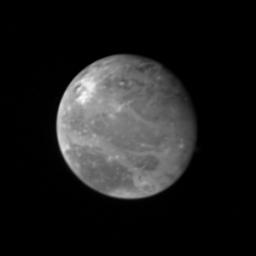
|
Ganymede at 2.6 million miles
- Click the image above for a larger view
- Full-Res JPEG (300 x 300) (4.2 kB)
- Full-Res TIFF (300 x 300) (33.8 kB)
Caption:
This photo of Ganymede, largest of Jupiter's Galilean satellites and the third from the planet, was taken shortly after midnight March 1, from a distance of 2.6 million miles (4.2 million kilometers). Ganymede is slightly larger than the planet Mercury, but is much less dense; it has roughly twice the density of water. Ganymede's surface brightness is four times that of Earth's Moon. This photo shows dark features reminiscent of the dark, mare regions on the Moon. On Ganymede, however, these features have twice the brightness of lunar mare. Scientists believe they are unlikely to be composed of rock or lava as the Moon's mare regions are. Ganymede's north polar region appears to be covered with brighter material, and scientists say it could be water frost. Later photos of Ganymede will be taken from closer range and will therefore have higher resolution if those photos of the polar region show underlying terrain blanketed by frost, it could indicate movement of water= across Ganymede's surface, possibly in a very thin atmosphere. Brighter spots are also scattered across this hemisphere of Ganymede. They may be related to impact craters, or may represent source regions of fresh ice.
Background Info:
JPL manages and controls the Voyager project for NASA's Office of Space Science.
Cataloging Keywords:
| Name | Value | Additional Values |
|---|---|---|
| Target | Ganymede | |
| System | Jupiter | |
| Target Type | Satellite | Planet |
| Mission | Voyager | |
| Instrument Host | Cassini Orbiter | Voyager 1 |
| Host Type | Orbiter | Flyby Spacecraft |
| Instrument | Imaging Science Subsystem (ISS) | |
| Detector | ||
| Extra Keywords | Atmosphere, Crater, Grayscale, Impact, Water | |
| Acquisition Date | ||
| Release Date | 1996-07-17 | |
| Date in Caption | ||
| Image Credit | NASA/JPL | |
| Source | photojournal.jpl.nasa.gov/catalog/PIA00351 | |
| Identifier | PIA00351 | |
